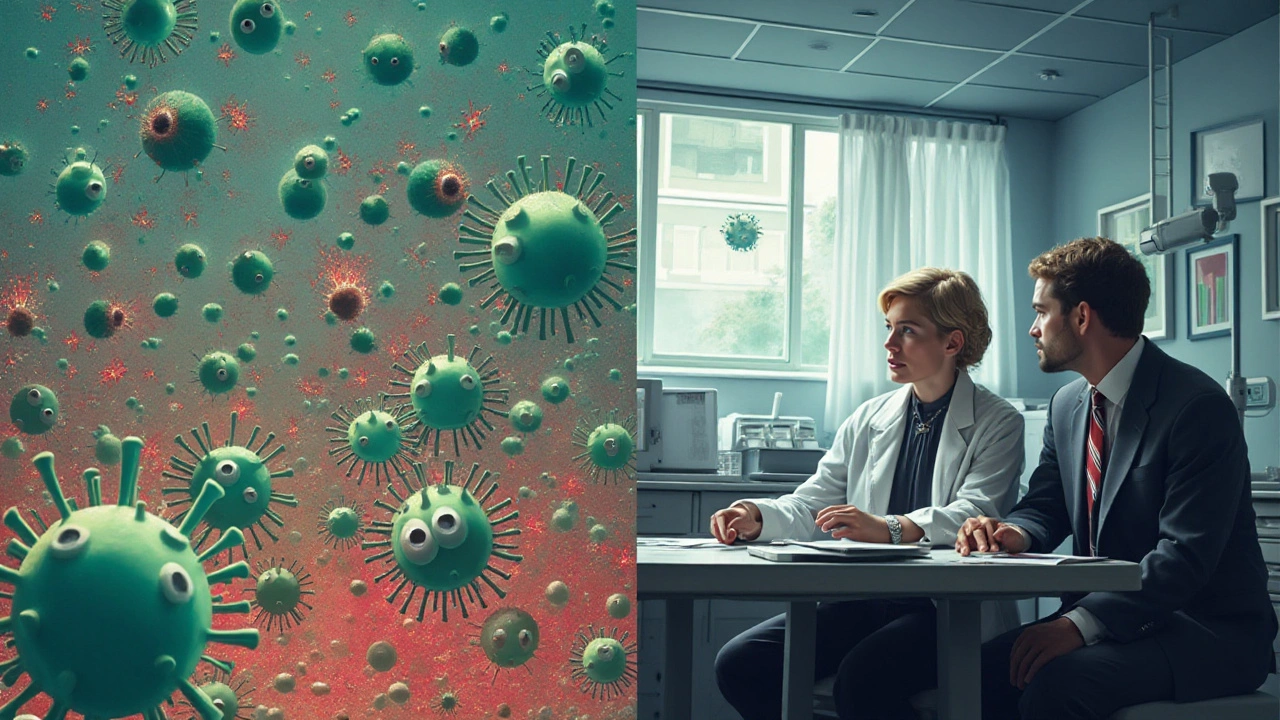 Jan, 31 2025
Jan, 31 2025
The quest for a single antibiotic capable of vanquishing all bacteria has intrigued scientists and healthcare professionals alike. But does such a miracle drug exist, or is it merely a figment of our hopeful imagination? Join us on a journey through the world of antibiotics, those remarkable agents that revolutionized medicine and drastically cut down mortality rates from bacterial infections.
In unraveling the assets and shortcomings of antibiotics, we come across fascinating insights into why a one-size-fits-all solution remains elusive. Despite the absence of an all-encompassing answer, understanding different antibiotics' activities sheds significant light on tailoring treatments to particular infections. As you uncover the reasons why it's crucial to tread carefully when using these drugs, remember – consultation with a healthcare practitioner remains a vital piece of the puzzle. Dive into the wondrous workings of antibiotics and equip yourself with knowledge that promises to empower your health decisions.
- Understanding Antibiotics
- The Spectrum of Antibiotic Activity
- Challenges in Eradicating All Bacteria
- Responsible Antibiotic Use
- Consulting Healthcare Professionals
Understanding Antibiotics
In our journey through the labyrinth of modern medicine, antibiotics emerge as a pillar of profound importance. These remarkable agents are the very foundation upon which therapeutic strategies against bacterial infections are built. Penicillin, discovered by Alexander Fleming in 1928, heralded a new era where bacterial afflictions like pneumonia and tuberculosis were no longer certain death sentences. Yet, this did not happen overnight. The meticulous process of deriving antibiotics initially from mold and later synthesizing them in labs has been one of the pivotal scientific advancements of the 20th century. It's intriguing how these medicines work by either killing bacteria outright or inhibiting their ability to multiply, thus giving our body’s immune system the upper hand to combat infections.
Antibiotics are not a monolith; they are as varied as the bacteria they fight. There are broad-spectrum antibiotics, like amoxicillin, capable of acting against a wide array of bacteria, and narrow-spectrum ones like azithromycin, which target specific infections. This diversity is crucial because it allows medical professionals to choose the right weapon against a particular bacterial foe. However, with great power comes great responsibility. The misuse of antibiotics, often arising from self-prescription or incomplete treatment courses, has led to the emergence of resistant strains of bacteria. This resistance is a growing concern globally and represents one of the major challenges in contemporary healthcare management. According to the World Health Organization, antibiotic resistance is one of the top 10 global public health threats.
"Without urgent action, we are heading for a post-antibiotic era, in which common infections and minor injuries can once again kill," said Dr. Tedros Adhanom Ghebreyesus, Director-General of WHO.
An interesting aspect of antibiotics is their role in agriculture. They have been used for decades in livestock to prevent disease and promote growth, contributing to the resistance challenge. Consider the balance required; while human health is paramount, the economic importance of agriculture cannot be dismissed. It is no wonder that international bodies advocate for restricted agricultural use to minimize resistance threats that can spill over to human medicine. Fortunately, scientific endeavors continue to race ahead, developing new antibiotics and alternative therapies such as bacteriophages or probiotics. These innovative solutions hint at a future where resilient infections can be tackled with renewed vigor.
In understanding antibiotics, one must also appreciate their limitations. They are ineffective against viral infections, such as the common cold or flu, a fact often misunderstood by the general populace. Here's where public education plays a crucial role. The necessity of consulting a healthcare provider before beginning an antibiotic regimen cannot be overstated. Medical professionals consider numerous factors, including the infection type, patient medical history, and existing antibiotic resistance patterns before prescribing treatment. Educational initiatives strive to inform individuals about responsible antibiotic use, safeguarding these powerful drugs for the present and future. Thus, the study and application of antibiotics weave together complex narratives of scientific discovery, public health, and the meticulous efforts needed to protect these indispensable tools in our medicinal arsenal.
The Spectrum of Antibiotic Activity
Exploring the vast universe of antibiotics, one cannot ignore the spectrum of activity that ranges from highly specialized to broad-ranging. Antibiotics operate through a fascinating mechanism of action, targeting and neutralizing bacterial threats within our bodies. Every antibiotic has a spectrum of activity, which essentially determines its effectiveness against specific bacteria. Some are categorized as broad-spectrum antibiotics, which have the capability to target and destroy a wide range of bacteria. These are generally prescribed when the exact cause of the infection isn't determined, and a prompt response is required. Notable examples include tetracycline and amoxicillin, both renowned for their versatility. In contrast, narrow-spectrum antibiotics, like penicillin, focus on specific bacteria and are used when the bacteria causing the infection is known.
The choice between broad and narrow-spectrum antibiotics is vital, often dictated by the nature and severity of the infection. Broad-spectrum antibiotics, while effective in eradicating multiple bacteria types, pose the risk of affecting beneficial bacteria alongside harmful ones, potentially leading to antibiotic resistance. This calls for judicious usage, emphasizing the importance of consulting healthcare professionals during treatment decisions. The efficacy of antibiotics is sometimes visualized in resistance charts showing bacterial susceptibility, a key tool in modern medicine. According to the Centers for Disease Control and Prevention, awareness of an antibiotic's range is crucial in avoiding the dire consequences of inappropriate antibiotic use.
"The rise of antibiotic resistance is a devastating reality, and navigating it requires an understanding of the right antibiotic spectrum," said Dr. Margaret Chan, former Director-General of the World Health Organization.
In understanding what makes an antibiotic effective, mechanisms such as inhibiting cell wall synthesis or protein production in bacteria are fundamental. These processes, studied over decades, reveal how antibiotics like chloramphenicol interfere with bacterial ribosomes, stopping protein synthesis dead in its tracks. Alternatively, drugs like ciprofloxacin disrupt DNA replication. Breaking down these functions is essential in the grand scheme of healthcare, setting the foundation for responsibly utilizing antibiotics to ensure they remain effective for future generations. Many factors contribute to an antibiotic's activity spectrum, ranging from its chemical structure to the precise bacterial targets it can affect. By appreciating these complexities, patients can better partake in informed discussions with their healthcare providers about their treatment options.

Challenges in Eradicating All Bacteria
When it comes to the fight against infectious diseases, modern medicine often spearheads its efforts with antibiotics. However, the idea of developing a singular antibiotic capable of defeating all bacterial threats presents formidable challenges. For starters, bacteria are incredibly diverse organisms. They inhabit various environments and have adapted in countless ways to survive, making it difficult to create one single drug that can address all these adaptations effectively. From coexistence in human intestines to thriving in the acidic oceans, each type of bacteria has unique life strategies and vulnerabilities.
The rapid rate of bacterial mutation exacerbates the difficulty in crafting an all-encompassing solution. Bacteria reproduce swiftly and can mutate their genetic material, potentially leading them to develop resistance to antibiotics faster than we can create them. This resistance often spreads through biological communities with astonishing speed, rendering many powerful drugs less effective than when they were first deployed. According to the CDC, antibiotic-resistant infections affect at least 2.8 million people in the U.S. alone each year, highlighting the critical need for alternative strategies and the pressing danger of relying on antibiotics as a singular solution.
The New York Times once reported, "The era of invincible antibiotics may be a fleeting moment in the vast history of medicine."The challenge also lies in distinguishing between harmful and beneficial bacteria. Our bodies host trillions of bacteria, many of which play essential roles in processes such as digestion and immune system regulation. An antibiotic that indiscriminately eliminates all bacteria could inadvertently dismantle these beneficial communities, leading to unintended health consequences. This necessity to preserve the good while eradicating the bad significantly complicates the goal of creating a universal antibacterial agent.
Moreover, ethical and economic considerations also come into play. Developing and testing new antibiotics is a costly endeavor, with considerable resources needed to move from laboratory synthesis to clinical trials. Often, pharmaceutical companies face significant financial pressures balancing the costs of development with the necessity of making drugs available at a reasonable cost to those in need. The economics of pharmaceuticals dictate that broad-spectrum antibiotics, which could potentially curb numerous bacteria, need to be judiciously managed to avoid premature resistance development due to overuse.
In conclusion, the ideal of a singular antibiotic solution remains distant. Although researchers persist in their efforts to outpace bacterial resistance, fostering a better understanding of bacteria and developing strategies that encompass not just antibiotics but also probiotic and other biotechnological advances, stands as our best hope. Collaborative efforts to monitor and manage antibiotic use, combined with international cooperation, are crucial steps toward a sustainable future in healthcare.
Responsible Antibiotic Use
Responsible use of antibiotics is essential to preserve their efficacy and ensure public health. These powerful drugs have saved countless lives, but misuse could lead to negative consequences. For instance, inappropriate use, such as not completing prescribed courses, can inadvertently contribute to antibiotic resistance. This resistance occurs when bacteria mutate, reducing the effectiveness of treatment. Understanding how to manage antibiotics wisely is crucial for maintaining their benefits for future generations. Patients play a significant role in this endeavor by adhering strictly to their healthcare provider's instructions.
In recent years, there has been a global push to promote awareness of these concerns. Healthcare practitioners hold the reins, but patients should be equally informed. Misunderstandings often arise, like assuming antibiotics are the cure-all for viral infections, which they are not suitable for. This distinction is critical because iterations of misconceptions perpetuate misuse. Instead, thoughtful dialogue between patient and doctor ensures antibiotics are prescribed only when genuinely needed. By aligning treatment with the specific type of infection, we can safeguard these valuable resources.
Guidelines for Proper Antibiotic Use
Effectively employing antibiotics involves a set of practices both healthcare professionals and patients must observe. Firstly, only take antibiotics after a confirmed bacterial infection diagnosis. Self-medicating or skipping doses accelerates resistance, risking the nightmare of untreatable infections arising. Keeping up with vaccinations also plays a pivotal role, as preventing infections reduces the need for antibiotics. According to a report by the World Health Organization, global vaccination programs significantly contributed to declining antibiotic demands. With responsibility, we prolong their effective lifespan and enhance societal health as a whole.
Let’s not overlook the environmental impact. Unused or expired antibiotics should never be discarded carelessly. Instead, return them to designated drop-off points, which many healthcare institutions provide. This responsible disposal prevents polluting ecosystems, thereby limiting the opportunity for bacteria to develop resistance outside the human body. This cross-sectoral approach ensures our environment remains as resilient as our health systems aspire to be. Additionally, healthcare providers should regularly engage in continuous education, updating their knowledge on microbial trends to inform prescriptions accurately.
"Responsible antibiotic use is not just a clinical decision; it is a commitment to health and the environment," emphatically states Dr. Marie Pham, an infectious diseases expert.
Information technology's role in promoting antibiotic stewardship cannot be understated. Digital record systems help practitioners swiftly identify a patient’s antibiotic history, minimizing prescription overlap. These systems also facilitate rapid data sharing among medical teams, bridging critical communication gaps. Patient education materials, available online through online doctor consultations, empower individuals with knowledge about when and why antibiotics matter. Patients informed on topics such as how antibiotics target specific bacteria, are notably proactive in managing their prescriptions.
To summarize, wise antibiotic use requires a collective effort involving healthcare providers and patients committed to change. It's not only about fixing current issues but progressively ensuring triumphs in managing bacterial infections. Together, they herald responsible practices that promise enduring efficacy and safety. In doing so, antibiotics remain formidable allies in medical care without unnecessary hazards. As we embrace responsibility, we embrace the promise of healthier futures for everyone.

Consulting Healthcare Professionals
In today's world of medical wonders and technological advances, the profound role of healthcare professionals in guiding antibiotic use cannot be overstated. These seasoned guardians of health possess the expertise to navigate the complex interplay between bacteria and antibiotics, making them indispensable allies in your health journey. Their insights and recommendations stem from a wealth of knowledge, acquired through rigorous education, clinical experience, and ongoing training. Thus, their counsel holds the potential to transform your treatment plan into a finely-tuned engine for restoring health.
Engaging with a healthcare professional offers more than a mere transactional encounter; it is a dynamic partnership rooted in trust and tailored care. They begin by conducting a meticulous assessment of your condition, delving into your medical history, symptoms, and even lifestyle factors. Armed with this comprehensive understanding, they proceed to identify the most suitable antibiotic, factoring in considerations like efficacy, potential side effects, and any underlying health issues.
The wisdom of healthcare professionals shines brightest when tackling the issue of antibiotic resistance, a growing global concern. They are adept at minimizing the risk of resistance by prescribing the right antibiotic at the right dose for the right duration. Their guidance extends to reminding patients of the critical importance of adhering to prescribed courses, thus preventing bacteria from mounting a comeback armed with resistance. Acknowledging this alarming trend, the World Health Organization emphasizes, "The world is heading towards a post-antibiotic era, in which common infections and minor injuries that have been treatable for decades can once again kill."
By pursuing regular consultations, you're investing in a future where infections are diagnosed with speed and treated with precision. Technologies like telemedicine bring this expert advice to your fingertips, opening doors for timely medical intervention. Online doctor consultations bridge geographical divides, empowering you with access to qualified professionals, no matter where your journey takes you. This synergy between technology and healthcare expertise ensures you are never alone in your pursuit of wellness.
Creating a robust rapport with your healthcare provider amplifies the efficacy of your treatment regimen. Beyond antibiotics, they offer counsel on preventive strategies, like vaccinations and lifestyle adjustments, enhancing your body's natural defenses against bacterial threats. Remember, the art of medicine is ever-evolving, and with healthcare professionals as your confidants, you embark on a proactive path toward better health decisions and improved outcomes.
